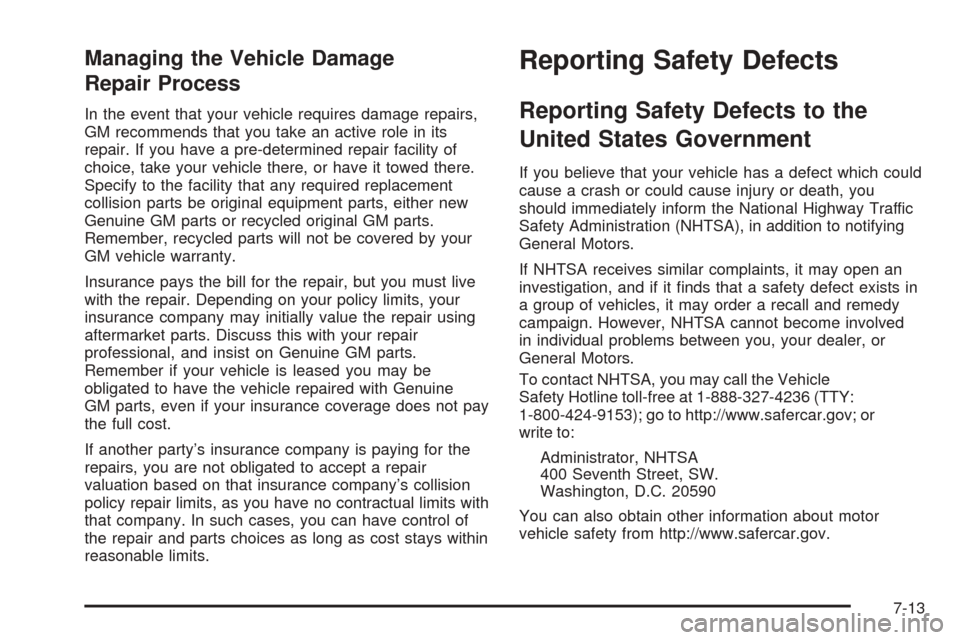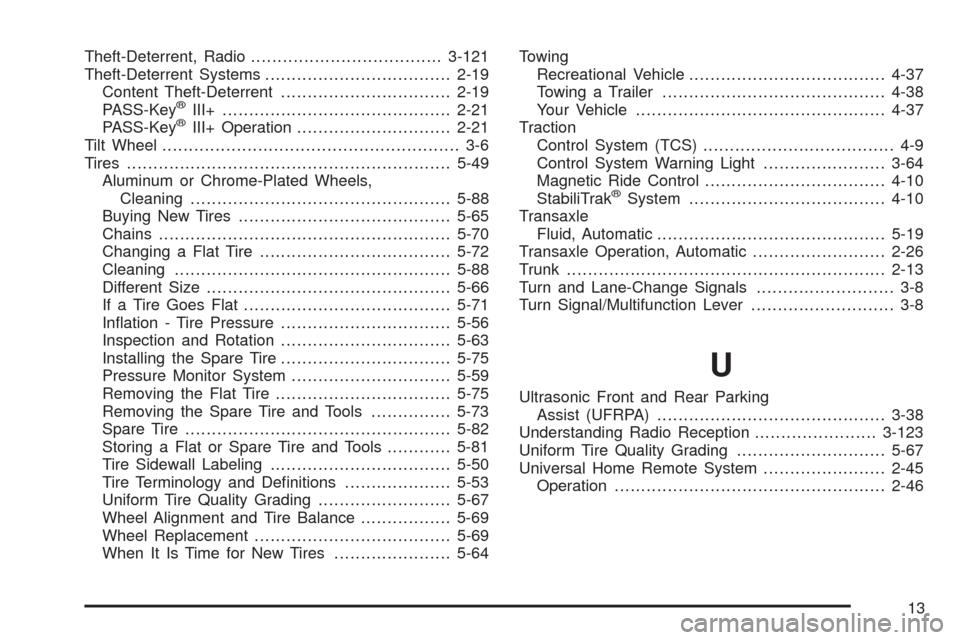4-9 CADILLAC DTS 2006 1.G User Guide
[x] Cancel search | Manufacturer: CADILLAC, Model Year: 2006, Model line: DTS, Model: CADILLAC DTS 2006 1.GPages: 450, PDF Size: 2.55 MB
Page 285 of 450

Driving on Snow or Ice
Most of the time, those places where the tires meet the
road probably have good traction.
However, if there is snow or ice between the tires and
the road, you can have a very slippery situation. You will
have a lot less traction, or grip, and will need to be
very careful.
What is the worst time for this? Wet ice. Very cold snow
or ice can be slick and hard to drive on. But wet ice
can be even more trouble because it may offer the leasttraction of all. You can get wet ice when it is about
freezing, 32°F (0°C), and freezing rain begins to fall. Try
to avoid driving on wet ice until salt and sand crews
can get there.
Whatever the condition — smooth ice, packed, blowing,
or loose snow — drive with caution.
Traction control improves your ability to accelerate when
driving on a slippery road. Even though your vehicle
has the Traction Control System (TCS), you will want to
slow down and adjust your driving to the road
conditions. Under certain conditions, you may want to
turn the TCS off, such as when driving through
deep snow and loose gravel, to help maintain vehicle
motion at lower speeds. SeeTraction Control System
(TCS) on page 4-9.
4-27
Page 289 of 450

Rocking Your Vehicle to Get It Out
First, turn your steering wheel left and right. That
will clear the area around your front wheels. You should
turn your traction control system off. SeeTraction
Control System (TCS) on page 4-9. Then shift back and
forth between REVERSE (R) and a forward gear,
spinning the wheels as little as possible. Release the
accelerator pedal while you shift, and press lightly on the
accelerator pedal when the transaxle is in gear. By
slowly spinning your wheels in the forward and reverse
directions, you will cause a rocking motion that may
free your vehicle. If that does not get you out after a few
tries, you may need to be towed out. If you do need
to be towed out, seeTowing Your Vehicle on page 4-37.
Loading Your Vehicle
It is very important to know how much weight your
vehicle can carry. This weight is called the vehicle
capacity weight and includes the weight of all occupants,
cargo, and all nonfactory-installed options. Two labels
on your vehicle show how much weight it may properly
carry, the Tire and Loading Information label and the
Certi�cation label.
{CAUTION:
Do not load your vehicle any heavier than the
Gross Vehicle Weight Rating (GVWR), or either
the maximum front or rear Gross Axle Weight
Rating (GAWR). If you do, parts on your
vehicle can break, and it can change the way
your vehicle handles. These could cause you
to lose control and crash. Also, overloading
can shorten the life of your vehicle.
4-31
Page 433 of 450

Managing the Vehicle Damage
Repair Process
In the event that your vehicle requires damage repairs,
GM recommends that you take an active role in its
repair. If you have a pre-determined repair facility of
choice, take your vehicle there, or have it towed there.
Specify to the facility that any required replacement
collision parts be original equipment parts, either new
Genuine GM parts or recycled original GM parts.
Remember, recycled parts will not be covered by your
GM vehicle warranty.
Insurance pays the bill for the repair, but you must live
with the repair. Depending on your policy limits, your
insurance company may initially value the repair using
aftermarket parts. Discuss this with your repair
professional, and insist on Genuine GM parts.
Remember if your vehicle is leased you may be
obligated to have the vehicle repaired with Genuine
GM parts, even if your insurance coverage does not pay
the full cost.
If another party’s insurance company is paying for the
repairs, you are not obligated to accept a repair
valuation based on that insurance company’s collision
policy repair limits, as you have no contractual limits with
that company. In such cases, you can have control of
the repair and parts choices as long as cost stays within
reasonable limits.
Reporting Safety Defects
Reporting Safety Defects to the
United States Government
If you believe that your vehicle has a defect which could
cause a crash or could cause injury or death, you
should immediately inform the National Highway Traffic
Safety Administration (NHTSA), in addition to notifying
General Motors.
If NHTSA receives similar complaints, it may open an
investigation, and if it �nds that a safety defect exists in
a group of vehicles, it may order a recall and remedy
campaign. However, NHTSA cannot become involved
in individual problems between you, your dealer, or
General Motors.
To contact NHTSA, you may call the Vehicle
Safety Hotline toll-free at 1-888-327-4236 (TTY:
1-800-424-9153); go to http://www.safercar.gov; or
write to:
Administrator, NHTSA
400 Seventh Street, SW.
Washington, D.C. 20590
You can also obtain other information about motor
vehicle safety from http://www.safercar.gov.
7-13
Page 449 of 450

Theft-Deterrent, Radio....................................3-121
Theft-Deterrent Systems...................................2-19
Content Theft-Deterrent................................2-19
PASS-Key
®III+...........................................2-21
PASS-Key®III+ Operation.............................2-21
Tilt Wheel........................................................ 3-6
Tires.............................................................5-49
Aluminum or Chrome-Plated Wheels,
Cleaning.................................................5-88
Buying New Tires........................................5-65
Chains.......................................................5-70
Changing a Flat Tire....................................5-72
Cleaning....................................................5-88
Different Size..............................................5-66
If a Tire Goes Flat.......................................5-71
In�ation - Tire Pressure................................5-56
Inspection and Rotation................................5-63
Installing the Spare Tire................................5-75
Pressure Monitor System..............................5-59
Removing the Flat Tire.................................5-75
Removing the Spare Tire and Tools...............5-73
Spare Tire..................................................5-82
Storing a Flat or Spare Tire and Tools............5-81
Tire Sidewall Labeling..................................5-50
Tire Terminology and De�nitions....................5-53
Uniform Tire Quality Grading.........................5-67
Wheel Alignment and Tire Balance.................5-69
Wheel Replacement.....................................5-69
When It Is Time for New Tires......................5-64Towing
Recreational Vehicle.....................................4-37
Towing a Trailer..........................................4-38
Your Vehicle...............................................4-37
Traction
Control System (TCS).................................... 4-9
Control System Warning Light.......................3-64
Magnetic Ride Control..................................4-10
StabiliTrak
®System.....................................4-10
Transaxle
Fluid, Automatic...........................................5-19
Transaxle Operation, Automatic.........................2-26
Trunk............................................................2-13
Turn and Lane-Change Signals.......................... 3-8
Turn Signal/Multifunction Lever........................... 3-8
U
Ultrasonic Front and Rear Parking
Assist (UFRPA)...........................................3-38
Understanding Radio Reception.......................3-123
Uniform Tire Quality Grading............................5-67
Universal Home Remote System.......................2-45
Operation...................................................2-46
13